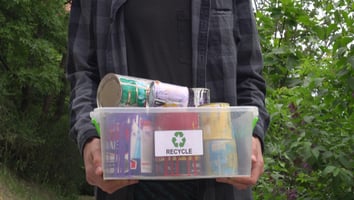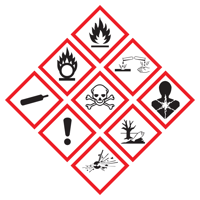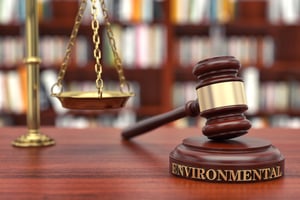One often overlooked provision of the Resource Conservation and Recovery Act (RCRA) is the...
What happens to my hazardous waste when it leaves my facility?
Understanding what happens to your hazardous waste down stream is very important because hazardous waste generators have what is known as cradle to grave responsibility, meaning they are ultimately responsible for ensuring their untreated hazardous waste is not disposed of improperly. In this article I will describe exactly what the typical hazardous waste journey looks like, how to determine how your waste is being treated by looking at the manifest and, finally, what steps you should take to ensure your waste is being handled properly when it leaves your facility.
Transporters
The first transfer of custody is between the generator and their waste transporter. Sometimes these waste companies also help generators create profiles for their waste streams and often make decisions about routing and treatment based on the information provided by the waste generator about their waste. They will often provide the required shipping documents (the hazardous waste manifest), labels and container markings required for transportation. It is a misconception that these items are the transporter's responsibility. Under the law it is the generator's responsibility as the offeror of the material to ensure it is properly packaged and shipping documents are filled out correctly. Let's take a look at what each party is signing to on the hazardous waste manifest.

Generator Certification: "I hereby declare that the contents of the consignment are fully and accurately described above by the proper shipping name, and are classified, packaged, marked and labeled/placarded, and are in all respects in proper condition for transport according to applicable international and national government regulations..."
Transporter: "Transporter Acknowledgement of Receipt of Materials"
As you can see, the generator is the one certifying the load is correct while the transporter only acknowledges receipt of the material. Granted, the transporter is required by law to verify the correctness of all loads and shipping documents and is typically the one on the receiving end of enforcement by the DOT if something is wrong with the load. All the same, it is important to know that the person signing the manifest for the generator is held personally liable for the correctness of waste shipments they sign for. Individuals who sign the hazardous waste manifest require special training under 40 CFR Parts 262 and 265, and 49 CFR Part 172 (subpart H).
After the waste is loaded onto a truck and the manifest signed, custody of the waste is transferred to the transporter. Less than load (LTL) shipments and shipments of material on multiple manifests bound for multiple disposal facilities are frequently transported to a transfer yard where waste can be stored for a period not to exceed 10 days and consolidated into full truck loads (FTL) to their respective destination along with other shipments of hazardous waste. FTLs and bulk waste are typically transported directly to their destination facility, unless that facility is located very far away. Sometimes, multiple transporters and transfer yards are required to get waste to its ultimate destination.
Treatment, Storage and Disposal Facilities (TSDFs):
The Hazardous and Solid Waste Amendments to the Resource Conservation and Recovery Act (RCRA) prohibit land disposal of untreated hazardous wastes. TSDFs are facilities permitted under RCRA to treat, store and dispose of hazardous wastes. Most TSDFs act as some combination of treatment, storage and disposal facility, often specializing in no more than one or two of treatment or disposal technologies.
Arrival
When waste arrives at a TSDF, waste containers are unloaded from the transporter's truck and inspected. Containerized waste is counted to ensure the count matches the manifest and samples are often pulled from the waste to verify the contents match the properties described in the waste stream profile. Bulk waste are sampled from their transport container and verified prior to being unloaded. Disposal facilities can issue discrepancies for wastes that do not conform to their profiled specifications or manifested counts, and reject the waste back to the generator. Sometimes discrepancies can be resolved simply by updating the manifest to reflect the correct count or modifying the waste stream profile to conform with the received waste at the the agreement of both generator and disposal facility.
Storage and Treatment
After container counts and contents are verified, containerized waste is segregated based on how it will be treated and moved into an appropriate storage unit. These wastes are often consolidated into bulk packaging before being sent off to another facility for disposal, such as when high BTU liquids are blended in tanks and sent to be burned as fuel at a concrete kiln. TSDFs that possess permits for on-site treatments, such as stabilization, neutralization or microencapsulation will perform these procedures on wastes in tanks or pits before shipping the treated waste to a landfill or other disposal site. I've listed a few common treatment technologies and their descriptions below. A longer list of recognized treatment technologies can be found at 40 CFR 268.42.
- FSUBS - Fuel substitution in units operated in accordance with applicable technical operating requirements, such as concrete kilns permitted to burn high BTU wastes as fuel replacement for coal. Wastes must have a value as fuel in order to qualify for this treatment.
- STABL - Stabilization of hazardous waste using inert material, typically concrete or fly ash, to reduce the leachable concentration of characteristically toxic metals and inorganics below their limits. Stabilized waste are then landfilled.
- NEUTR - Neutralization of characteristically corrosive waste using acids and bases so that the pH of the waste is greater than 2 and less than 12.5.
Often a disposal facility will receive waste that it does not treat at that site in order to consolidate the waste before re-manifesting the material to another facility with the appropriate permitted treatment technology. This waste is manifested with the shipping facility listed as the generator.
Disposal
Treated hazardous wastes that meet EPA treatment standards can be buried in a landfill, injected into a well or otherwise disposed of. Some hazardous waste constituents require incineration or combustion to properly destroy. When waste is combusted in an incinerator or kiln, part of the material's mass is released into the atmosphere as exhaust while the slag and ash left behind are landfilled. Advanced scrubber systems and after treatments are effective at treating the hazardous exhausts of a waste incinerator, but scrubber solutions periodically have to be changed out creating more solid waste to be landfilled.
Reduce, Re-use, Recycle, Reclaim
So let's address the elephant in the room here: your waste eventually ends up in the ground or in the atmosphere. This is just a reality of matter, and why it is so important to reduce the amount of hazardous waste you generate by controlling the purchase of hazardous goods, offering unused material for re-use and recycling wastes that can be reliably recycled.
When recycling hazardous waste, generators need to be extra careful to understand how their recycled waste is regulated. The EPA has several different exclusions and alternative standards for recycled material. If you have determined that a waste is hazardous, unless it falls into one of these specific exclusions or alternative programs, then it must be handled as a hazardous waste.
The good news is that there are several common hazardous waste treatments that offer some amount of reclamation or recovery of the waste material. The most common of these are fuel blending, metals recovery and energy recovery of waste.
Determining how your hazardous waste is being treated.
Many hazardous waste generators want to simply call a disposal company and trust them to make sure their waste is handled correctly from there. While the waste industry is typically very good about making sure waste is treated and disposed of properly, leaving so much in the hands of a third party company can be a risky proposition. To find out where and how your waste is being treated, all you need to do is look at the hazardous waste manifest.

Box 8 of the Hazardous Waste manifest is where you can find the disposal facility name, site address, and EPA ID number. This is the TSDF your waste is being shipped to. TSDFs frequently have audit packages available online or by request. You can also use the EPA ID number to search RCRAInfo for information about that disposal facility.

In box 19 you will find the hazardous waste management codes corresponding to the category of treatment employed by the disposal facility to treat the waste listed on the corresponding line of the hazardous waste manifest. These management codes are listed below:

These codes are used to report waste generation and treatment information to the EPA, and are needed to complete the biennial report and annual waste summaries (Texas Generators). Management codes H010, H020, H039, H050 and H061 are methods of reclamation and recovery and can often be included in waste minimization plans for generators who are required to participate in waste minimization under RCRA.
If the management code H141 is used, that means the disposal facility you shipped your waste to did not do any treatment, recovery or disposal of the waste. Often this just means that the waste could be more economically transported and treated after being sorted and consolidated at that facility. Sometimes, however, waste is routed to a disposal facility simply because it is owned by the same company that provides you transportation and other industrial services. Unless it is logistically impractical, shipping directly to the facility that best treats and/or disposes of your waste is preferred.
Conclusion:
The logistics of hazardous waste are complicated. Because of the way waste generation and disposal is closely tracked, each link in the chain adds complexity and cost. Ideally generators would always ship directly to a facility that will treat and dispose of their waste, but often volume and distance sometimes require the waste to pass through a facility that only consolidates or aggregates. It is important for Generators to understand where and how their hazardous waste is being treated, so they can ensure it is being treated appropriately and make informed decisions about their sustainability and budgeting goals. Here are a few ways you can make sure your hazardous waste is being handled appropriately and effectively:
- Look at the manifest to determine where and how your waste is currently being treated.
- Request copies of the disposal facility's audit package and your transporter's security and spill prevention plan.
- Ensure hazardous waste employees receive proper training
- Find out if wastes that are currently being disposed of can be reused, recycled or partially reclaimed
For more information about recycling under RCRA check out the EPA's hazardous waste recycling page.




